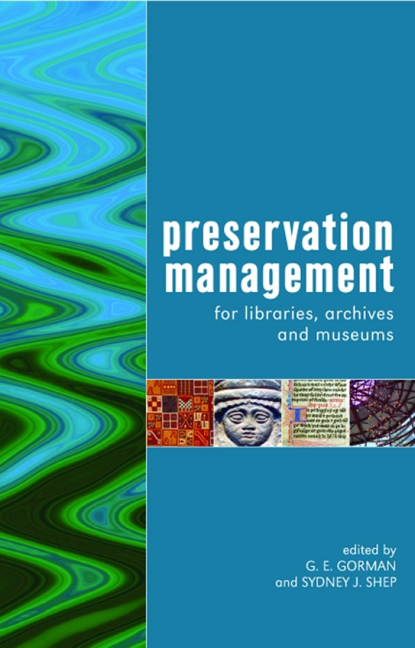Book contents
- Frontmatter
- Contents
- About the contributors
- Introduction
- 1 Managing the documentary heritage: issues for the present and future
- 2 Preservation policy and planning
- 3 Intangible heritage: museums and preservation
- 4 Surrogacy and the artefact
- 5 Moving with the times in search of permanence
- 6 Valuation model for paper conservation research: a new approach for setting research priorities
- 7 Preservation of audiovisual media: traditional to interactive formats
- 8 Challenges of managing the digitally born artefact
- 9 Preserving cultural heritage in times of conflict
- 10 Access and the social contract in memory institutions
- 11 Redefining ‘the collection’ in the 21st century
- Index
Introduction
Published online by Cambridge University Press: 08 June 2018
- Frontmatter
- Contents
- About the contributors
- Introduction
- 1 Managing the documentary heritage: issues for the present and future
- 2 Preservation policy and planning
- 3 Intangible heritage: museums and preservation
- 4 Surrogacy and the artefact
- 5 Moving with the times in search of permanence
- 6 Valuation model for paper conservation research: a new approach for setting research priorities
- 7 Preservation of audiovisual media: traditional to interactive formats
- 8 Challenges of managing the digitally born artefact
- 9 Preserving cultural heritage in times of conflict
- 10 Access and the social contract in memory institutions
- 11 Redefining ‘the collection’ in the 21st century
- Index
Summary
Forty years ago, on 4 November 1966, the River Arno in Florence burst its banks. In the days, weeks, months and years that followed, the fundamentals of book and paper conservation science were rewritten and new disciplines were forged: disaster management, preservation conservation and preservation management. This watershed moment, so to speak, has since been joined by spectacular episodes of cultural genocide. The 1992 burning of the National Library in Sarajevo, as well as the 1991 bombing campaign against the medieval city of Dubrovnik by Slobodan Milosevic's Serb nationalists, bore witness to the attempted erasure of Bosnian and Croatian ethnic identity. The Taleban's demolition of the Bamiyan Buddhas in 2001 destroyed 17 centuries of Afghan pre- Islamic sacred cultural heritage. The opportunistic looting of Baghdad's National Museum and the torching of the National Library and Archives in 2003 provoked international outrage, particularly as the invading forces did nothing to prevent the removal, destruction, sale, or relocation of cultural property.
However, there have been quieter revolutions to counterpoint the drama of flood, fire and war. Identification of the brittle books and slow fires syndrome drew attention to the dangers of self-consuming heritage artefacts and led to the formation of the Commission on Preservation and Access. From 2000, the highly publicized showdown between Nicolson Baker and the library and archive communities galvanized public thinking about the immanence of the original. Most recently, the global turn to digitization has forced scholars, collectors, curators and institutions to rethink and restructure their primary modes of operation.
Preservation management now sits at the top of the agenda for memory institutions around the world. It is a topic of ongoing debate as collection development strategies, policies and practices are negotiated between libraries, museums, archives, funding agencies and governments. Historically separate cultural institutions are now converging to share limited resources, develop compatible ideologies and co-ordinate distributed collections. In this climate, preservation and access are twin sides of the same coin: curatorial responsibilities are enhanced; the public is empowered.
- Type
- Chapter
- Information
- Preservation Management for Libraries, Archives and Museums , pp. xiii - xviiiPublisher: FacetPrint publication year: 2006
- 1
- Cited by



